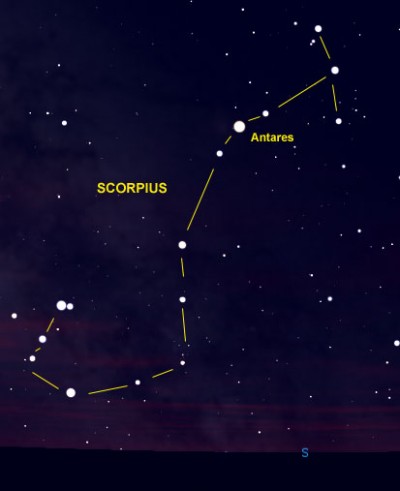
July is a grand time of year to learn to recognize the constellation Scorpius the Scorpion. If you’re in the city – with no dark sky – you probably won’t see the entire constellation. But you can still see the star that represents the Scorpion’s Heart, a bright red star called Antares. Our chart shows the nights of July 27, 28 and 29, 2020, when the moon will approaching this star and then passing it. Watch for the moon on these nights! Despite its glare, Antares’ red color will likely be noticeable to you.
If you do have a dark sky, you can see the graceful shape of Antares’ constellation Scorpius. The constellation has a J-shape. From the Northern Hemisphere, the bottom half of Scorpius – the curved part of the J – is close to the southern horizon when Scorpius is at its highest in the sky, as it is in the evening in July.
From the Southern Hemisphere, the graceful shape of Scorpius appears higher in the sky, closer to overhead.
But – from either hemisphere, assuming you have a dark sky – you can recognize this constellation and its bright red star Antares.

Scorpius is one of the few constellations that looks like its namesake. The bright red star Antares marks the Scorpion’s Heart. Notice also the 2 stars at the tip of the Scorpion’s Tail. These 2 stars – Shaula and Lesath – are known as The Stinger.
When Scorpius is high in the sky in the evening, you know it’s time to look for another constellation, Orion the Hunter, before dawn. Orion and Scorpius are never in the sky at the same time. In one of skylore’s most charming legends, it’s said that vain Orion grew so boastful about his hunting skills that he claimed there was no animal he could not kill. When he boasted he would kill every animal on earth, Gaia, the Goddess of the Earth, sent Scorpius the Scorpion to sting and kill Orion. It’s said that Zeus, the ruler of the gods in Greek mythology, placed Orion and the Scorpion in the heavens in such a way that the two enemies would never meet. Thus when the Scorpion is at its peak in visibility in the evening sky – high in the sky on late July evenings – Orion is just returning to the east before sunrise. Read more: Orion the Hunter returns before dawn.
Bottom line: July is a good month for learning to recognize the J-shaped constellation Scorpius. The moon will be approaching and then sweeping past the brighest star in Scorpius, red Antares, on July 27, 28 and 29, 2020.
from EarthSky https://ift.tt/2X11kqH

July is a grand time of year to learn to recognize the constellation Scorpius the Scorpion. If you’re in the city – with no dark sky – you probably won’t see the entire constellation. But you can still see the star that represents the Scorpion’s Heart, a bright red star called Antares. Our chart shows the nights of July 27, 28 and 29, 2020, when the moon will approaching this star and then passing it. Watch for the moon on these nights! Despite its glare, Antares’ red color will likely be noticeable to you.
If you do have a dark sky, you can see the graceful shape of Antares’ constellation Scorpius. The constellation has a J-shape. From the Northern Hemisphere, the bottom half of Scorpius – the curved part of the J – is close to the southern horizon when Scorpius is at its highest in the sky, as it is in the evening in July.
From the Southern Hemisphere, the graceful shape of Scorpius appears higher in the sky, closer to overhead.
But – from either hemisphere, assuming you have a dark sky – you can recognize this constellation and its bright red star Antares.

Scorpius is one of the few constellations that looks like its namesake. The bright red star Antares marks the Scorpion’s Heart. Notice also the 2 stars at the tip of the Scorpion’s Tail. These 2 stars – Shaula and Lesath – are known as The Stinger.
When Scorpius is high in the sky in the evening, you know it’s time to look for another constellation, Orion the Hunter, before dawn. Orion and Scorpius are never in the sky at the same time. In one of skylore’s most charming legends, it’s said that vain Orion grew so boastful about his hunting skills that he claimed there was no animal he could not kill. When he boasted he would kill every animal on earth, Gaia, the Goddess of the Earth, sent Scorpius the Scorpion to sting and kill Orion. It’s said that Zeus, the ruler of the gods in Greek mythology, placed Orion and the Scorpion in the heavens in such a way that the two enemies would never meet. Thus when the Scorpion is at its peak in visibility in the evening sky – high in the sky on late July evenings – Orion is just returning to the east before sunrise. Read more: Orion the Hunter returns before dawn.
Bottom line: July is a good month for learning to recognize the J-shaped constellation Scorpius. The moon will be approaching and then sweeping past the brighest star in Scorpius, red Antares, on July 27, 28 and 29, 2020.
from EarthSky https://ift.tt/2X11kqH

Aucun commentaire:
Enregistrer un commentaire